The Apple iPad Pro Review
by Ryan Smith, Joshua Ho & Brandon Chester on January 22, 2016 8:10 AM ESTSystem Performance Cont'd
Continuing on with our more game-like benchmarks, tests like 3DMark and GFXBench are supposed to replicate gaming workloads to help determine relative performance in most common 3D games. In the case of the iPad Pro, the GPU is a 12 cluster variant of the PowerVR Series7XT GPU architecture. This is double the number of clusters relative to the A9’s GPU, which should prove to be quite impressive judging by the GPU performance that we saw in the iPhone 6s.
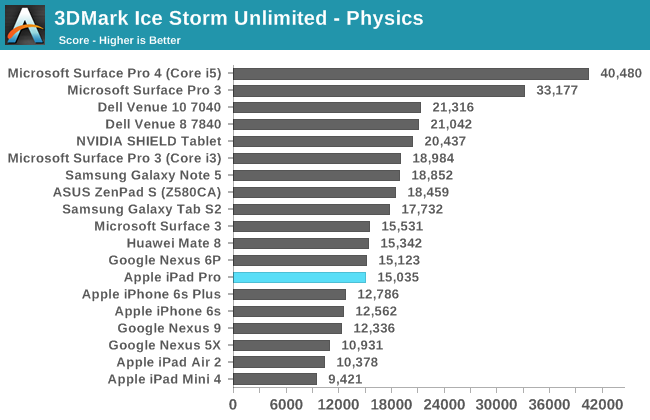
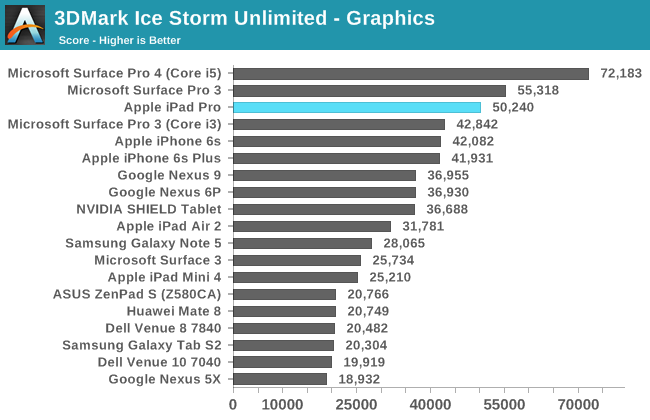
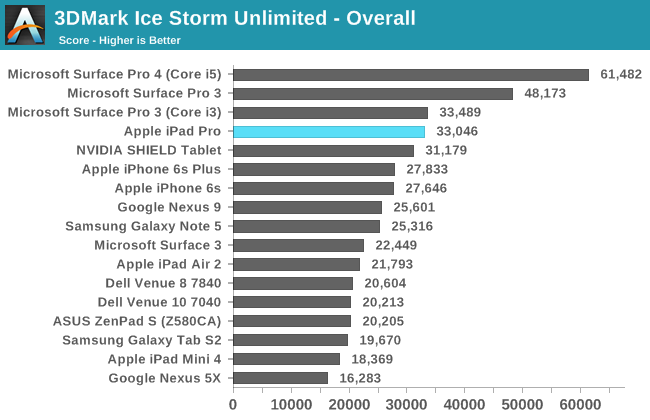
The iPad Pro manages to maintain superiority in 3DMark, but we're really starting to see the limitations of this test. The physics test generates non-sequential data structures with memory dependencies, which can penalize devices with lower core count and clock speed, but the workload is able to be spread across multiple cores to exploit TLP, which benefits devices with more real cores, or virtual ones (hyperthreading). We also see that the graphics test isn't really scaling well at this point as it's just too light to take advantage of the full potential of the A9X GPU. This likely also explains why the iPad Pro isn't closer to the Surface Pro 4 in performance on this benchmark, given what we know about A9X's GPU.
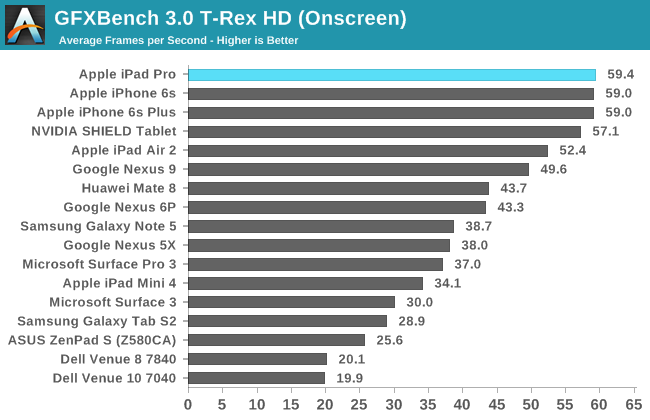
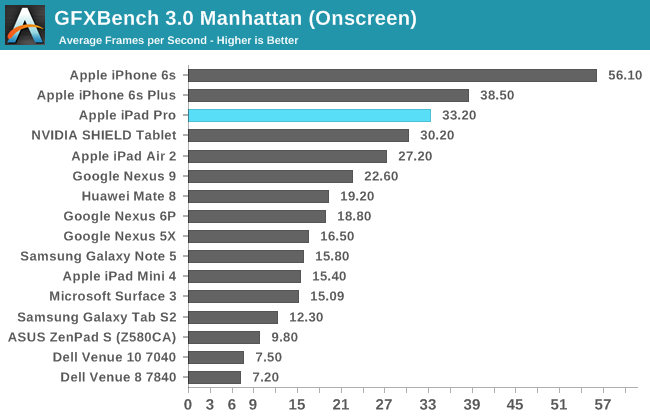

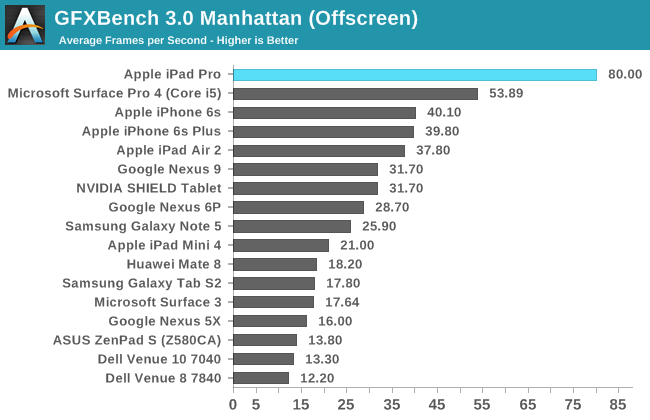
In GFXBench we can see the major benefits that really come with the larger GPU. It's pretty obvious here that clock speeds are basically identical when comparing the A9 GPU and A9X GPU as the scaling is almost perfectly double. In this benchmark the iPad Pro quite handily beats the Surface Pro 4, but it's important to keep in mind that the Surface Pro 4 is running a higher level of precision and that the iPad Pro is running OpenGL ES rather than OpenGL in this test, so it isn't strictly apples-to-apples (nor is such a thing truly possible at this time). Overall though the GPU of the iPad Pro is incredibly impressive, and I doubt that anyone will really have issues with gaming performance on this device.
NAND Performance
At this point it’s pretty well understood that storage performance can often be a gating factor in performance. Although caching is an amazingly effective method of hiding memory latency, for the first hit it’s mandatory to miss the cache unless you’ve managed to prefetch the data in question. The other issue where storage performance becomes obvious are cases where it’s necessary to commit data to storage first. Some cases where this is going to be obvious is app installation or iCloud restores, especially when network performance is at the point where installation can actually be gated by writing to disk rather than downloading from the network.
In the case of the iPad Pro, Apple claims that they’ve implemented a storage controller comparable to some desktop SSDs. It turns out that this controller is a familiar one, as the storage controller identifies itself as the APPLE SSD AP0128K in the case of this review unit. It turns out that everything about this SSD is identical to what we saw in the iPhone 6s as well, down the use of Hynix for at least one of the NAND vendors and the hybrid SLC/TLC architecture discussed in previous articles. In order to test how this storage solution performs we once again use Eric Patno’s StorageBench, which provides a rough analogue to AndroBench 3.6.
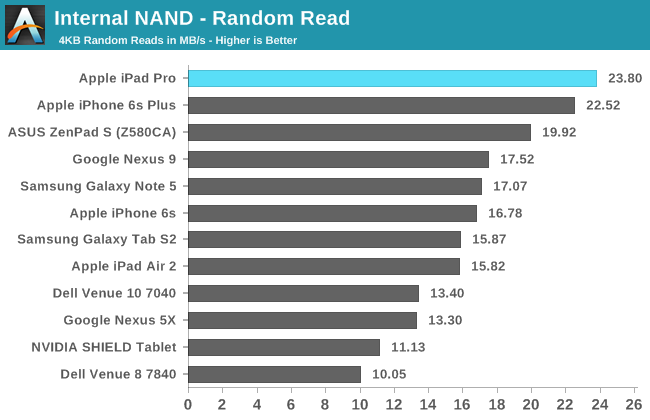

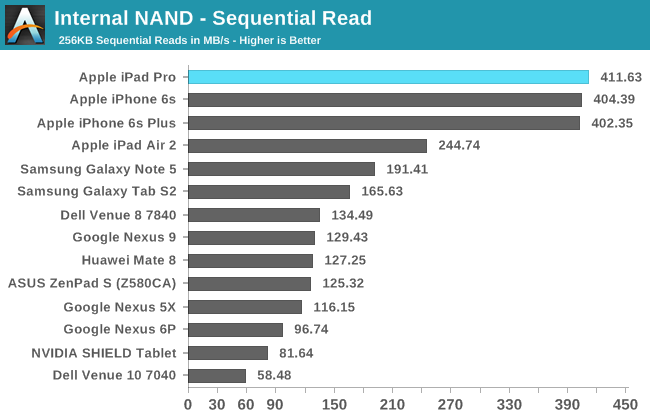
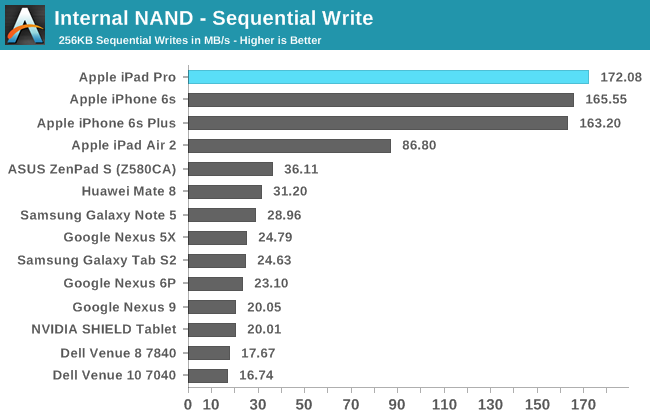
It turns out that in this test, performance is basically identical to the iPhone 6s. This isn’t quite the equal of something like the Surface Pro 4’s PM951 SSD, which has the advantage of more NAND dies working in parallel, but given that the iPad Pro PCB size isn’t going to be anywhere near that of the Surface Pro 4 it’s likely that this is a concession to gain better battery life. I definitely wonder what performance would be like relative to a Surface Pro 4 if the iPad Pro had a 512GB SKU, but given that the iPad Pro tops out at 128GB this isn’t really a question with a relevant answer.










408 Comments
View All Comments
HammerStrike - Friday, January 22, 2016 - link
"I beg your pardon, Miss Taggart," he had said, offended. "I don't know what you mean when you say that I haven't made use of the metal. This design is an adaptation of the best bridges on record.What else did you expect?”
"A new method of construction."
"What do you mean, a new method?"
"I mean that when men got structural steel, they did not use it to build steel copies of wooden bridges."
Ann Rand, "Atlas Shrugged"
The question around the iPad Pro is not is it a close enough copy of a workstation to do workstation work, but does it enable new work streams that were previously unexplored. As has been previously noted, the Surface Pro 4 is an extremely capable piece of hardware that checks all the same boxes as the iPad Pro, but no software had been designed to take advantage of it's unique form factor - it's still using a wooden design on a steel bridge.
The real differentiation for the iPad Pro is iOS, and the touch first / mobility first design mentality it brings to the table - software has to be written specifically for that environment and usage case. There are some notable hardware and input difference between the iPad Pro and previous iOS devices - time will tell if they can be combined to provide real productivity improvements vs previous designs or if they are merely novelties that will be quickly forgotten. Jury is still out on that, but if anyone can build the "critical mass" to jump start that exploration it's Apple. Hopefully some apps come out and wow us - to channel Asimov, there is a single light usage case advancement, and to progress it anywhere is to progress it everywhere.
name99 - Friday, January 22, 2016 - link
I simply cannot figure your complaint: "It is a computer, REDUCED to an accessory, which COULD be THAT MUCH MORE USEFUL."So what do you want? You want the iPad Pro form factor running OSX? You want the ability to plug in a second screen? You want to be able to install Windows?
Your complaint seems to be "this is not a Surface Pro 4". It isn't MEANT to be.
It's meant to be a larger screen version of an iPad, for those for whom an iPad is an appropriate device. If you're not one of those people, WTF does it matter to you? Do you hang around bicycle tracks telling everyone there they should be using a motorbike or a car or a truck because those are more powerful?
You are stuck in a certain vision of what a computer is "supposed" to be, every bit as much as IBM confronted by DEC couldn't imagine a computer that wasn't a mainframe, then DEC confronted by Apple, Atari, etc couldn't imagine a computer that wasn't a mini, then in 2007 people couldn't imagine a pocket computer.
If you want to think of this as an "accessory" to a Mac, go ahead. I don't see what the value of that analogy, or why it's supposed to be an insult (Apple grew to the company it is today on the back of that accessory, the iPod...). People loved their iPods, they love their iPhones (especially the way they work together seamlessly with their Macs), and I expect they will love their iPad Pros.
Jumangi - Saturday, January 23, 2016 - link
Actually it is being touted as surface competition. Apple PR pushes this as a laptop replacement and its pricing is right with the Surface. Totally valid to compare the two.Constructor - Saturday, January 23, 2016 - link
You can do that. And Apple does indeed propose it as such – among very many other things, quite a few of which are actually better served by an iPad than by a conventional notebook.Just one example among many: The ability to simply use it in portrait mode already makes a huge difference for anything document-related, for which the narrow widescreens on computers are woefully inadequate.
MaxIT - Saturday, February 13, 2016 - link
Indeed it is. And it's way better than a Surface Pro, because it runs an OS that is actually designed to be used with a touch interface, while the Surface doesn't....Relic74 - Saturday, February 27, 2016 - link
Windows 10 was designed to be used with touch as well, it's silly to even think otherwise. People who such things have never used one before, simple as that.The Hardcard - Friday, January 22, 2016 - link
It's not about now. Yes now I have a laptop for things my device can't do, and a desktop for things my laptop can't do timely.But I am excited that soon devices that can be carried and pocketed will soon be powerful enough and have the software to do every thing I want to do in a timely fashion.
The iPad Pro marks the beginning of the final stage of the mobile transition, being THE computer for all mainstream activities.
There will still be larger form factors, just as there will still be mainframes. But most homes and many business won't have them.
In fact, that is what IBMs new angle is. The occasional or particular high-power computation you need done elsewhere, results served to your device. Most people won't even need that
RafaelHerschel - Saturday, January 23, 2016 - link
Conditioning I guess. Some people can't imagine that using the right tool for the job is more important than using a form factor that was originally designed for media consumption.Ananke - Friday, January 22, 2016 - link
Pros use Oracle, SAP, Cytrix for 98% of hardware, and some other exotic stuff amounts for the 2% left...Hence, nobody will approve capital expense of $1000+ on software unsupported device, when a $329 workstation can just do it. Software companies don't bother to bring the huge databases to exotic silicon either, when there are already CHEAPER well developed alternatives.Tablets are great for POS terminals, some apps that require mobile high quality visual content, and that's it pretty much. There is just no functionality need for something else, especially an expensive one.
mrcaffeinex - Friday, January 22, 2016 - link
In the office where I work, the iPad Pro may be the device people have been looking for. All of our remote application access goes through Citrix, with the most-used applications being Outlook for e-mail, Word for document review/minor editing, and Adobe Reader for PDF viewing. The experience on the iPad currently is not great, because the desktop versions of these applications do not translate well to the touch-first environment. The stylus and keyboard cover, coupled with the enhanced resolution, could make a difference.It is not a solution for everyone, but I have been fielding calls from our users already about wanting these, so there is potentially some kind of market to cater to here. I realize that from a technology standpoint there are more powerful alternatives and that there are other ways to approach the software situation, but at the end of the day, this is the kind of device that our users want: an iPad with a slightly bigger screen, responsive stylus input, and a keyboard cover in a convenient package, not to mention the implied prestige of Apple product ownership (in some circles the image is considered very important).
Time will tell if this is a fad or a long-term product line strategy. If Apple can turn a profit with these (and they do have a history of turning a profit on their devices), even in spite of a limited market appeal, they will probably keep marketing them.